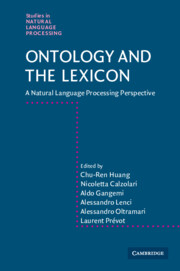Book contents
- Frontmatter
- Contents
- Contributors
- Preface
- Part I Fundamental aspects
- Part II Discovery and representation of conceptual systems
- 6 Experiments of ontology construction with Formal Concept Analysis
- 7 Ontology, lexicon, and fact repository as leveraged to interpret events of change
- 8 Hantology: conceptual system discovery based on orthographic convention
- 9 What's in a schema?
- Part III Interfacing ontologies and lexical resources
- Part IV Learning and using ontological knowledge
- References
- Index
6 - Experiments of ontology construction with Formal Concept Analysis
from Part II - Discovery and representation of conceptual systems
Published online by Cambridge University Press: 06 July 2010
- Frontmatter
- Contents
- Contributors
- Preface
- Part I Fundamental aspects
- Part II Discovery and representation of conceptual systems
- 6 Experiments of ontology construction with Formal Concept Analysis
- 7 Ontology, lexicon, and fact repository as leveraged to interpret events of change
- 8 Hantology: conceptual system discovery based on orthographic convention
- 9 What's in a schema?
- Part III Interfacing ontologies and lexical resources
- Part IV Learning and using ontological knowledge
- References
- Index
Summary
Introduction
Ontologies are constructs of domain-specific concepts, and their relationships are used to reason about or define that domain. While an ontology may be constructed either manually or semi-automatically, it is never a trivial task. Manual methods usually require that the concept architecture be constructed by experts who consult dictionaries and other text sources. For example, the Upper Cyc Ontology built by Cycorp was manually constructed with approximately 3,000 terms (Lenat, 1998). Automatic and semi-automatic methods require two separate steps in which the first step acquires domain-specific terms followed by the second step of identifying relations among them from available lexicons or corpora. As lexicons are a good resource and are helpful for ontology construction, Chapters 5 and 15 discuss the problems involving ontology construction and lexicons. To use the available corpus resource, a common approach for automatic acquisition employs heuristic rules (Hearst, 1992; Maedche and Staab, 2000). However, such a method can only acquire limited relations.
One new approach in the automatic construction of ontologies (Cimiano et al., 2004) is FCA (Formal Concept Analysis), a mathematical data analysis approach based on the lattice theory. Because formal concept lattices are a natural representation of hierarchies and classifications, FCA has evolved from a pure mathematical tool to an effective method in computer science (Stumme, 2002), such as in the automatic construction of an ontology (Cimiano et al., 2004). The focus of this work is on how to use FCA to construct a domainspecific ontology based on different Chinese data sources.
- Type
- Chapter
- Information
- Ontology and the LexiconA Natural Language Processing Perspective, pp. 81 - 97Publisher: Cambridge University PressPrint publication year: 2010
- 2
- Cited by



